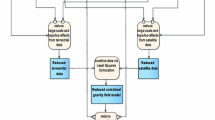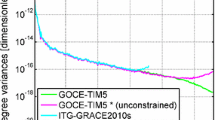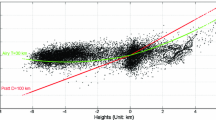Abstract
Because of its importance to many Earth science analyses, it is worth assessing whether gravity modelling can be simplified depending on the intended purpose and required precision. While it is obvious that large-scale gravity studies should account for the sphericity of the Earth, each case should be examined on its own merits. Demonstrations are useful for providing estimates of the errors in much simpler 2D modelling. The example of the Mid-Atlantic Ridge serves to compare “large” 2D and spherical 3D models. My model extends horizontally ±2,000 km (±18°) from the model profile across and along the straight ridge axis (along a great circle) and to a depth of 82 km across the axis. 3D modelling would generally be considered obligatory, but this is not clearly necessary from this study. The density structure is highly idealised, the asthenospheric uplift or lithosphere thinning is simplified. The Bouguer anomaly is fitted by least-squares for the density contrast, and the 2D–3D difference of the results is taken as the error. A lithosphere–asthenosphere density contrast of 86.56 kg/m3 was computed for the 2D model, and 84.14 kg/m3 for the spherical model. The difference is small, in the order of 3%, well within all the other uncertainties. My study shows that despite the significant sphericity of the structure, 2D models are well suited for such ridge studies, or generally for models with a laterally extended layered structure, and that spherical modelling can be applied discriminately.



Similar content being viewed by others
References
Artemieva IM, Mooney WD (2002) Thermal thickness and evolution of Precembrian lithosphere: a global study. J Geophys Res 106:16387–16416. doi:10.1029/2000JB900439
Çavşak H (1992) Dichtemodelle für den mitteleuropäischen Abschnitt der EGT aufgrund der gemeinsamen Inversion von Geoid, Schwere und refraktionsseismisch ermittelter Krustenstruktur (in German: Density models for the central European Section of EGT on the basis of joint inversion of geoid, gravity and refraction seismic crustal structure). Ph.D. Thesis, Mainz University
Chapman ME (1979) Techniques for interpretation of geoid anomalies. J Geophys Res 84:3793–3801. doi:10.1029/JB084iB08p03793
Cochran JR, Talwani M (1978) Gravity anomalies, regional elevation, and the deep structure of the North Atlantic. J Geophys Res 83:4907–4924. doi:10.1029/JB083iB10p04907
Fischer HJ (1984) Erfassung der Schwereanomalie über ozeanischen Rücken und ihre Deutung. Diploma thesis, Geophys, Frankfurt
Holstein H (2002a) Gravimagnetic similarity in anomaly formulas for uniform polyhedra. Geophysics 67:1126–1133. doi:10.1190/1.1500373
Holstein H (2002b) Invariance in gravimagnetic anomaly formulas for uniform polyhedra. Geophysics 67:1134–1137. doi:10.1190/1.1500374
Holstein H, Schürholz P, Starr AJ, Charkraborty M (1999) Comparison of gravimetric formulas for uniform polyhedra. Geophysics 64:1438–1446. doi:10.1190/1.1444648
Jacoby WR, Çavşak H (2005) Inversion of gravity anomalies over spreading oceanic ridges. J Geodyn 39:461–474. doi:10.1016/j.jog.2005.04.011
Jonson LR, Litehiser JJ (1972) A method for computing the gravitational attraction of three-dimensional bodies in a spherical or ellipsoidal Earth. J Geophys Res 77:6999–7009. doi:10.1029/JB077i035p06999
Pohánka V (1988) Optimum expression for computation of the gravity field of a homogeneous polyhedral body. Geophys Prospect 36:733–751. doi:10.1111/j.1365-2478.1988.tb02190.x
Rapp RH (1977) Potential Coefficient Determination from Terrestrial Gravity Data. Rep. Dept. Geodetic Science, 251, Ohio State University, 1977
Takin M, Talwani M (1966) Rapid computation of the gravitation attraction of topography on a spherical Earth. Geophys Prospect 14:119–142. doi:10.1111/j.1365-2478.1966.tb01750.x
Talwani M (1973) Computer usage in the computation of gravity anomalies. In: Methods in computational physics, vol 13. Academic Press, New York, NY, pp 343–389
Talwani M, Lamar WJ, Landisman M (1959) Rapid gravity computations for two-dimensional bodies with application to the Mendocino submarine fracture zone. J Geophys Res 64(1), 49–59, 1
Vesper H (1984) Erfassung von Schwereanomalien über ozeanischen Rücken und ihre Deutung. Diploma thesis, Geophys, Frankfurt
von Frese RRB, Hinze WJ, Braile LW, Luca AJ (1981) Spherical Earth gravity and magnetic anomaly modeling by Gauss–Legendre quadrature integration. J Geophys 49:234–242
Vyskocil V, Burda M (1976) On the computation of the gravitational effect of three-dimensional density models of the Earth’s crust. Stud Geophys Geod 3:213–218. doi:10.1007/BF01601900
Acknowledgments
I thank my former advisor, Prof. Dr. Wolfgang Jacoby for his suggestions, encouragement and efforts with helping me formulate this work in English. I thank Dr Horst Holstein, from whom I have benefited through helpful discussions. I also thank Dr. Peter Clift for his suggestions. The reviewers gave further helpful criticism.
Author information
Authors and Affiliations
Corresponding author
Appendix
Appendix
Calculation of the potential and the gravity effect
The 2D calculations were carried out with the widely known Talwani method (Talwani et al. 1959). For the 3D calculations the program INVGRA. for was written by the first author as part of his PhD thesis (Çavşak 1992). The parametrization of arbitrarily shaped uniform mass bodies is based on triangulated polyhedra, a classical method in gravity calculations (e.g. Chapman 1979; Holstein et al. 1999; Holstein 2002a, b; Pohánka 1988). A brief outline of the method follows below as it had been derived in a non-traditional way.
Given is the terrestrial x, y, z coordinate system with z pointing downward in g direction. The basic unit of the massive polyhedron is defined by the tetrahedron expanded from the observation point O to any of the planar triangles. Their orientation is arbitrary in (x, y, z). A coordinate transformation is carried out (by vector operations) to the triangle-oriented coordinate system (ξ, η, ζ), such that the triangle is in the ξ–η plane and one of its edges (A–B) is parallel to ξ, see Fig. A-1.
The potential effect is given by
where h is the height of tetrahedron (Fig. A-1)
Analytical integration renders \( \Updelta U = \frac{1}{2}G \cdot \rho \cdot h \cdot F\left( {\eta ,\xi } \right) \) with
(Chapman 1979), from which follows:
The gravity effect is
The formal differentiation leads to a lengthy expression, not reproduced here. It reduces to
With the z component of the normal unit vector of the respective triangle \( \hat{\zeta }_{z} = \frac{\partial }{\partial z}\left( h \right) \) and \( Y^{\prime} = \frac{\partial }{\partial z}\left( Y \right) \) we can write
Rights and permissions
About this article
Cite this article
Çavşak, H. Gravity effect of spreading ridges: comparison of 2D and spherical models. Mar Geophys Res 29, 161–165 (2008). https://doi.org/10.1007/s11001-008-9052-y
Received:
Accepted:
Published:
Issue Date:
DOI: https://doi.org/10.1007/s11001-008-9052-y





